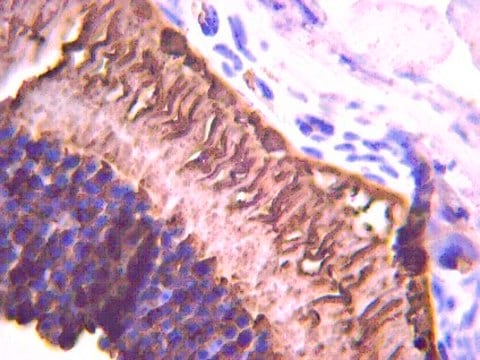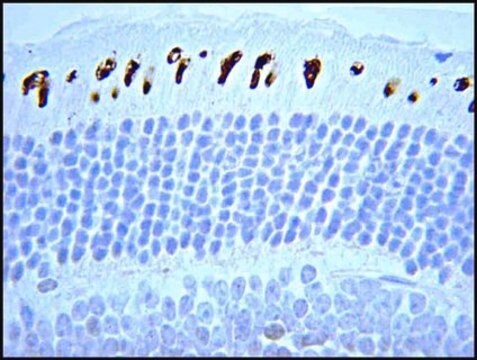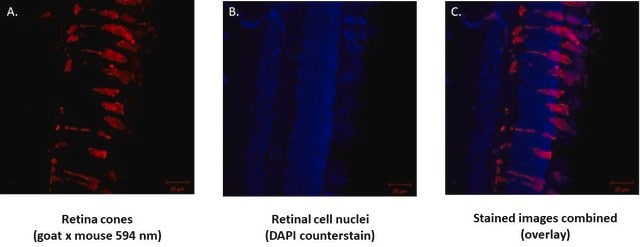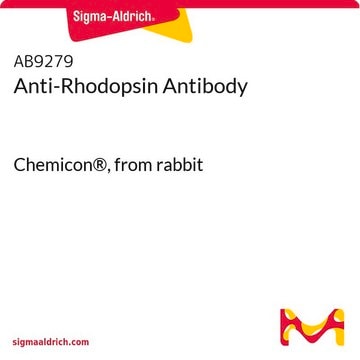MAB5356
Anti-Rhodopsin Antibody, CT, last 9 amino acids, clone Rho 1D4
clone Rho 1D4, Chemicon®, from mouse
Synonym(e):
Anti-CSNBAD1, Anti-OPN2, Anti-RP4
About This Item
Empfohlene Produkte
Biologische Quelle
mouse
Qualitätsniveau
Antikörperform
purified immunoglobulin
Antikörper-Produkttyp
primary antibodies
Klon
Rho 1D4, monoclonal
Speziesreaktivität
vertebrates
Hersteller/Markenname
Chemicon®
Methode(n)
immunocytochemistry: suitable
immunohistochemistry: suitable
immunoprecipitation (IP): suitable
western blot: suitable
Isotyp
IgG1
NCBI-Hinterlegungsnummer
UniProt-Hinterlegungsnummer
Versandbedingung
wet ice
Posttranslationale Modifikation Target
unmodified
Angaben zum Gen
human ... RHO(6010)
Spezifität
Immunogen
Anwendung
Neurowissenschaft
Sensorik & Peripheres Nervensystem (PNS)
Western blot of isolated bovine rod outer segment labeled for rhodopsin (~85% of rod outer segment protein) with the rho 1D4 antibody. Amount of rod outer segments applied to the SDS gel: (a) 2.5 mg; (b) 0.63 mg; (c) 0.16 mg; (d) 0.04 mg. At higher protein quantities, dimers, trimers and tetramers of rhodopsin can be observed along with the monomer.
Immunohisto/cytochemistry: 1:100-1:500 on paraformaldehyde and glutaraldehyde fixed frozen tissue sections. Preferred fixation is paraformaldehyde for 4 hours at 2-8°C. Suggested permeabilization method is 0.2% Triton X-100.
Immunoprecipitation
Optimal working dilutions must be determined by the end user.
Zielbeschreibung
Physikalische Form
Lagerung und Haltbarkeit
Hinweis zur Analyse
Eye
Sonstige Hinweise
Rechtliche Hinweise
Haftungsausschluss
Not finding the right product?
Try our Produkt-Auswahlhilfe.
Empfehlung
Lagerklassenschlüssel
10 - Combustible liquids
WGK
WGK 2
Flammpunkt (°F)
Not applicable
Flammpunkt (°C)
Not applicable
Analysenzertifikate (COA)
Suchen Sie nach Analysenzertifikate (COA), indem Sie die Lot-/Chargennummer des Produkts eingeben. Lot- und Chargennummern sind auf dem Produktetikett hinter den Wörtern ‘Lot’ oder ‘Batch’ (Lot oder Charge) zu finden.
Besitzen Sie dieses Produkt bereits?
In der Dokumentenbibliothek finden Sie die Dokumentation zu den Produkten, die Sie kürzlich erworben haben.
Unser Team von Wissenschaftlern verfügt über Erfahrung in allen Forschungsbereichen einschließlich Life Science, Materialwissenschaften, chemischer Synthese, Chromatographie, Analytik und vielen mehr..
Setzen Sie sich mit dem technischen Dienst in Verbindung.







